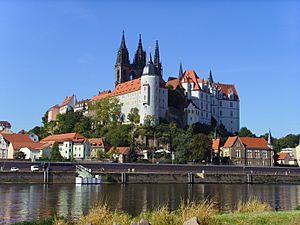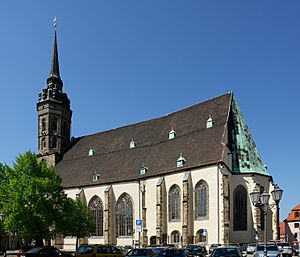Roman Catholic Diocese of Dresden–Meissen facts for kids
Quick facts for kids Diocese of Dresden-MeissenDioecesis Dresdensis-Misnensis Bistum Dresden-Meißen |
|
|---|---|
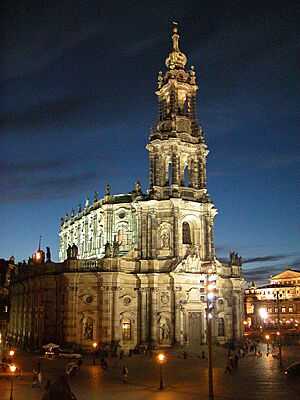
Dresden Cathedral
|
|
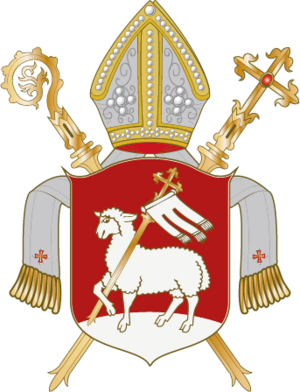
Coat of arms
|
|
| Location | |
| Country | |
| Ecclesiastical province | Berlin |
| Metropolitan | Berlin |
| Statistics | |
| Area | 16,934 km2 (6,538 sq mi) |
| Population - Total - Catholics |
(as of 2019) 4,097,028 141,717 (3.5%) |
| Information | |
| Denomination | Catholic |
| Sui iuris church | Latin Church |
| Rite | Roman Rite |
| Established | 968 Founded as the Bishopric of Meissen 24 June 1921 as Diocese of Meissen 15 November 1979 renamed Diocese of Dresden-Meissen |
| Cathedral | Katholische Hofkirche, Dresden |
| Co-cathedral | St. Peter's, Bautzen |
| Patron saint | St. Benno of Meissen Donatus of Arezzo Afra of Augsburg |
| Current leadership | |
| Pope | Francis |
| Bishop | Heinrich Timmerevers Bishop of Dresden-Meissen |
| Metropolitan Archbishop | Heiner Koch |
| Emeritus Bishops | Joachim Reinelt |
| Map | |
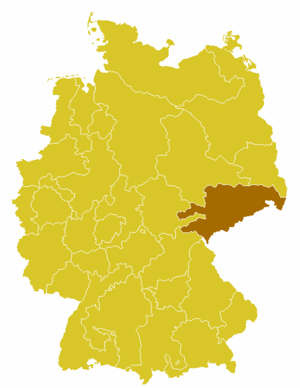 |
|
The Diocese of Dresden–Meissen is a special area of the Catholic Church in Germany. It's like a church district with its main office in Dresden. This diocese works closely with the Archdiocese of Berlin, which is a larger church area.
It started as the Bishopric of Meissen way back in 968. But it stopped existing in 1539 because of the Protestant Reformation. The diocese was brought back in 1921. In 1980, its name changed to Dresden–Meissen. Today, its main church is Dresden Cathedral. This beautiful church was built between 1739 and 1755. The diocese's special protector is Benno of Meissen, a saint.
Contents
History of the Diocese
Early Beginnings in Meissen
The city of Meissen began around 928. King Henry I the Fowler built a castle there. This castle helped protect German settlers among the pagan Wends. To help spread Christianity, Emperor Otto I wanted to create a main church area in Magdeburg.
In 968, three new church areas were planned. These were Meissen, Merseburg, and Zeitz. They would be part of the larger Archbishopric of Magdeburg. The exact year the Diocese of Meissen started is debated. However, records show Emperor Otto I supported it in 971.
The first bishop, Burchard, started a church group. This group grew into a chapter of canons in the 11th century. By 1346, the diocese covered a large area. It stretched from the Ore Mountains in the south to the Oder river in the north.
Spreading Christianity
The main job of the early bishops was to convert the Wends to Christianity. Bishops Volkold and Eido I worked hard on this. But the process was slow. Then, a big conflict called the investiture conflict made things harder.
Saint Benno (1066–1106) was bishop during this tough time. He was first loyal to Emperor Henry IV. But in 1076, Henry put him in prison. After escaping, Benno supported Pope Gregory VII. He was removed from his job by the emperor.
Later, Benno made peace with Henry. He became bishop again in 1086. He then focused completely on missionary work among the Slavs. In the 13th century, the Wends finally became Christians. This was largely thanks to large Cistercian monasteries. Important ones included Dobrilugk and Neuzelle.
Later bishops became powerful leaders. They were known as prince-bishops. Wittigo I (1266–1293) started building the amazing Gothic cathedral in Meissen. Nine princes of the House of Wettin are buried there. John I of Eisenberg (1340–1371) was a close friend of Emperor Charles IV. He helped protect the church's interests and increased its money.
In 1365, Pope Urban V gave the archbishop of Prague special authority over Meissen. But the Archbishopric of Magdeburg disagreed. So, Meissen stayed under Magdeburg's control for a while.
The Reformation and Changes
The Hussite Wars caused much damage to the diocese. This happened when John IV Hofmann (1427–1451) was bishop. But under the brothers Caspar and Dietrich of Schönberg, it recovered quickly.
John VII of Schleinitz (1518–1537) strongly opposed Martin Luther. Luther's ideas started in nearby Wittenberg. John tried to stop the new teachings. He even pushed for Saint Benno to be made a saint in 1523. This was to counter the spread of Lutheranism.
However, the Protestant Reformation continued to spread. After Duke George died in 1539, it became very strong in Saxony. Even some church officials became Protestant. The diocese was close to falling apart.
The last bishop, John of Haugwitz (1555–1581), resigned. He became a Lutheran, got married, and retired. The rulers of Saxony took control of the church's lands. The remaining monasteries became Protestant. Their money and buildings were used for education.
The Apostolic Prefecture of Meissen
Before he resigned, Bishop Haugwitz appointed Johannes Leisentritt. Leisentritt was in charge of the church areas in Lusatia, outside of Saxony. In 1567, the Pope created the Apostolic Prefecture of Meißen. This new church area was based in Bautzen. It was like a diocese that was still being approved.
This prefecture was also called the Apostolic Prefecture of the Two Lusatias. When Saxony took over Lusatia in 1635, it promised to keep the existing religious situation. After 1821, some parts of the prefecture were given to the Prussian Prince-Bishopric of Breslau. The remaining part was called the Apostolic Prefecture of (Saxon) Upper Lusatia.
Rebirth of the Diocese
On June 24, 1921, Pope Benedict XV officially re-established the Diocese of Meißen. The main office moved to Bautzen. Before this, there was also an Apostolic Vicariate in the Saxon Hereditary Lands in Dresden. This vicariate covered Catholic people in other parts of Saxony and Thuringia. In 1921, its area was also added to the new Meißen diocese.
Between 1945 and 1948, the number of Catholics in the Meißen diocese grew a lot. Many Catholic refugees came from former Eastern Germany and Czechoslovakia. Because of this, many new parishes (local church communities) were created.
Some Catholic parishes in Saxony were lost after World War II. Their members had to leave or were expelled by Poland. In 1948, Bishop Petrus Legge gave up his authority over these Polish-annexed areas. In 1972, Pope Paul VI officially made these areas part of the Archdiocese of Wrocław in Poland.
The Diocese of Dresden-Meissen Today
In 1980, the main office of the diocese moved to Dresden. This led to the diocese being renamed Dresden-Meissen. Since 1994, the dioceses of Berlin, Dresden-Meißen, and Görlitz form a new church group. Berlin is the main church area in this group.
Where the Diocese Is
The diocese covers most of the Free State of Saxony. It also includes parts of Thuringia. It is divided into nine smaller church areas called deaneries:
See also
- Bishop of Dresden-Meissen
- Roman Catholicism in Germany


